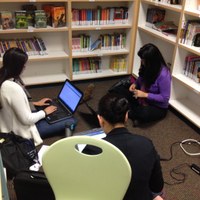Project 2: PLC Lead Teacher/Common Core PDs
Overview
This year our school held Professional Learning Communities (PLCs) for one academic quarter. Teachers engaged in conversations around literacy design and instruction. Dufour (2004) says, “School mission statements that promise ‘learning for all’ have become a cliché. But when a school staff takes that statement literally – when teachers view it as a pledge to ensure the success of each student rather than as politically correct hyperbole – profound changes begin to take place.” Dufour, an expert in the area of PLCs, explains that there are three core principals of professional learning communities: (1) Ensuring That Students learn, (2) A Culture of Collaboration and (3) A Focus on Result. At the end of the day, if teachers are committed to student learning and work collaboratively to reach their learning goals, students and teachers will be successful. PLCs can offer schools a structure to facilitate this type of environment.
 Main Activities
Main Activities
PLC #1: Laying the Foundation PLC was focused on assigning roles, establishing norms, looking over the assessment calendar and thinking about alignment in instruction.
PLC #2: Guided Reading Group Conference Plan for teachers was focused on planning guided reading instruction and conferencing using a template that was provided for ELA teachers in grades 5-8.
Research on PLCs: Part of being able to successfully facilitate the PLCs was having a knowledge base of the research.
Reflection
The two PLCs that we held offered a refreshing alternative to traditional professional developments in the sense that teachers guided the conversation and the work. Had we kept with this structure, I believe it could have led to very powerful conversations and analysis of student work, design of vertically aligned rubrics for our school. Teachers do need structured spaces such as PLCs to engage in critical analysis of our work and spaces where we can get professional feedback from those doing the work on a day-to-day basis.
Connection to CPSEL
Standard 2: A school administrator is an educational leader who promotes the success of all students by advocating, nurturing, and sustaining a school culture and instructional program conductive to student learning and staff professional growth.
2.1 Develop School Culture and Ensure Equity: Shape a culture in which high expectations are the norm for each student as evident in rigorous academic work. Promote equity, fairness, and respect among all members of the school community.
2.2 Guide the Instructional Program: Facilitate the use of a variety of appropriate content-based learning materials and learning strategies that: Recognize students as active learners, value reflection and inquiry, emphasize the quality versus the amount of student application performance, and utilize appropriate and effective technology
2.3 Guide Professional Growth of Staff: Guide and support the long-term professional development of all students relative to the content standards. Provide opportunities for all members of the school community to develop and use skills in collaboration, distributive leadership, and shared responsibility.
2.4 Create and Utilize Accountability Systems: Create an accountability system grounded in standards-based teaching and learning. Utilize multiple assessments to evaluate student learning in an ongoing process focused on improving the academic performance of each student.

